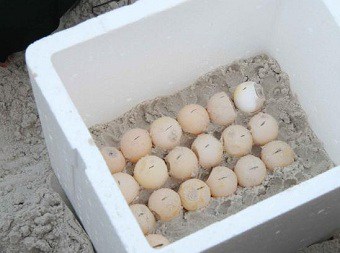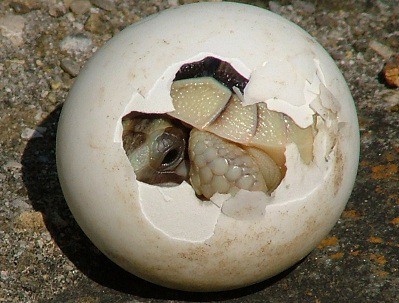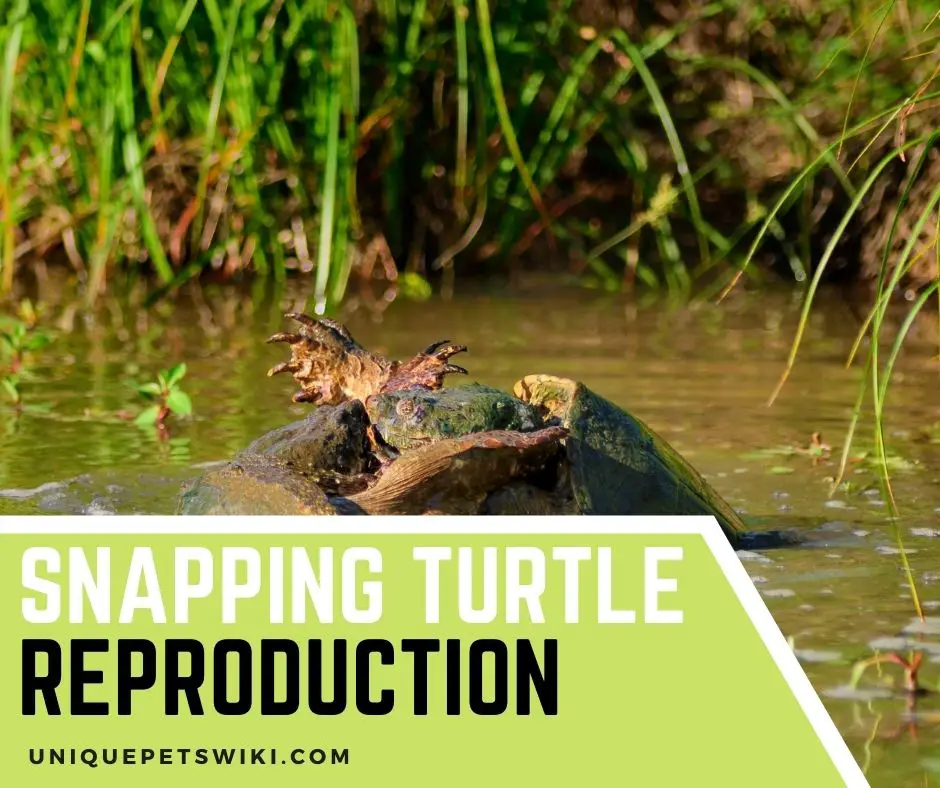Living organisms have an inherent tendency to mate and reproduce offspring of their kind. When animals reach adulthood (that is, become sexually active), they begin to look for and become interested in the opposite sex. Similarly, snapping turtles do mate. This article on snapping turtle reproduction aims to educate you on how snapping turtles mate in the wild, their mating season, and how to take care of their eggs when it’s laid.
Read on to learn more!
This article has been reviewed by Dr. Gospel. Read more about our knowledge control process here.
Contents
Overview About Snapping Turtle Reproduction
Snapping turtles have been kept as pets for generations and are one of the most fascinating turtle species. They are not only hardy and take less maintenance than other pet breeds such as dogs and cats, but they are also gentle and easy to care for as pets.
Snapping turtles are significantly distinct from other turtle species in terms of appearance. Snapping turtles have a distinctive big head, enormous body size, and a 19-inch-long, exceptionally long, and flexible neck capable of rotating in any direction, which they use to protect themselves when threatened.
Unlike other sea turtles and tortoises, Snapping turtles have a nearly flat carapace (shell), a small plastron, a short pointed snout, and a sharp hooked beak. Their shells vary in color to include tan, dark brown, and black. This lack of large shells and plastron to protect themselves is why they act aggressively and defensively when faced with threats.
In the wild, snapping turtles are observed to mate between April and November. After which, the mated female will become active in breeding during the warmer months.
When Can Snapping Turtles Breed?
When it comes to reptiles, sexual maturity and readiness to reproduce are determined by age and weight (size). Alligator snapping turtles mate and lay eggs when they are about 11 to 13 years old.
On the other hand, sexual maturity in common snapping turtles varies greatly depending on their living condition. The common snapping turtles will likely reach sexual maturity anywhere from 8 to 20 years old, depending on where they live.
For instance, if you feed your pet common snapping turtle appropriately, at age 8, your snapper should weigh big enough to mate and reproduce.

Mating Season Of Snapping Turtles
Mating in snapping turtles usually takes place between April and November, after which the female snapping turtle will begin reproducing throughout the warmer months.
The Habit Of Finding A Mate And Mating
All land tortoises and turtles mate by the male mounting on the female from her back and the male adjusting his tail to insert his semen into the female’s cloaca. On the flip side, snapping turtles and all aquatic turtles, in general, have a different method of mating.
Before the mating begins, the sexually active male will pursue the female to get her to be interested in mating. When the female has consented, they will both come face to face with each other under the water while they swim by their sides.
By coming face to face with each other, it means that they face each other with their plastron. Coming face to face with each other will enable the male to easily insert his penis into the female’s cloaca compared to land tortoises that have to climb the female’s back.
However, in captivity, snapping turtles can assume any position when mating, such as mounting on the female.
Gestation Of A Snapping Turtle
It’s worth noting that female snapping turtles can keep sperm and even fertilized eggs in their bodies for up to three years until they’re ready to lay the eggs.
Because of their ability to store sperm for a more extended period for future use, it’s difficult to measure or detect when the female’s eggs were fertilized by the sperm she keeps in her body. Therefore, the gestation period of snapping turtles is unknown.
But that notwithstanding, you can still detect when your mated female snapping turtle is gravid if you keep a close eye on her and pay close attention to both slight and major changes in her behavior, size, or even eating habits.
These might take a while or even many months but you’ll notice in time if she’s pregnant and ready to lay eggs. When a gravid female snapping turtle is about to deposit her eggs, she would appear restless.
Snapping Turtles Nests And Lays Eggs
When the temperature becomes warmer, usually around spring and summer, snapping turtles will begin to dig their nests in dry, sandy regions close to a pond or river. By April, they’ll lay 20 to 40 eggs in their nests. They can deposit up to 100 eggs in a single nest on rare occasions.
The Habit Of Nesting
In the wild, gravid female snapping turtles about to lay their eggs usually leave the water to dig a safe nest a few kilometers away from the water. This usually happens during the warmer months where the atmospheric temperature is warm enough to incubate the eggs.

The nests are usually around 5 to 7 inches deep, 2 to 3 inches broad, and usually a few miles away from a freshwater body.
The reason for digging her nest near a water body is so that the hatchlings could make it to a nearby water body before a predator could kill it.
In captivity however, you’ll need to manually create a dry area where your pet can lay her eggs. If by chance you fail to notice on time when she was about to lay eggs and create conditions favourable for her, she might suffer egg binding and die.
As mentioned earlier, signs that your snapper is gravid with eggs are if she appears bulky (extremely big with protruding stomach/sides) and if she acts restless, always adjusting her position as though to feel comfortable.
The Habit Of Laying Eggs
Female snapping turtles lay massive clutches of eggs in a single birth because they know their eggs and hatchlings have a slight chance of surviving.
The reason for building a nest a few kilometers closer to a water source is to make it easy for the hatchlings to discover the nearest water body when they hatch before a predator can feast on them.
Snapping turtle eggs and hatchlings, on the other hand, were frequently preyed on before reaching adulthood.
Incubation And Hatching
Animals that reproduce by laying eggs always require extra care for the eggs to hatch successfully. Snapping turtles don’t care for their eggs in the wild, nor do they care for their young. The eggs, when laid, are incubated naturally by the temperature of the environment.
However, in captivity, when your pet snapper lays her eggs, you’ll need to correctly pick the eggs, arrange them in an incubator and leave it to hatch.
Moreover, this is not as simple as it sounds because, in captivity, you should give care to the position of the eggs as they are laid. If you distort the laying position, it’ll kill the embryo, and the eggs will not hatch.
For this reason, it is advised that you mark the part of the eggs facing up and ensure you place them that way into the incubator. It is also important to note that the incubating temperature determines the sex of the hatchlings.
Eggs that hatch as males are incubated within the temperature of 73-75°F, while eggs hatched as females are set at a temperature of 68°F. Eggs maintained at 70-72°F will produce both male and female snapping turtles.

Read one of our articles to learn more about incubating snapping turtle eggs (How Do You Take Care Of Snapping Turtle Eggs?).
From Incubation To Hatch
As mentioned earlier, when the female snapping turtle is about to lay her eggs, she digs a nest on the land about 5 to 7 inches deep and 2 to 3 inches broad.
The female snapping turtle would cover her clutch with sand after depositing her eggs and then go without checking on the eggs. The buried (incubated) eggs will begin to hatch after three to four months (90 to 120 days).
Incubation occurs naturally in the wild, and the temperature of the environment facilitates it. For snapping turtles and reptiles in general, not only does temperature incubates the eggs but also determines the sex of the hatchlings as well as how fast or slow the incubation will take.
In a nutshell, the hotter the incubation temperature is, the quicker the eggs will hatch and vice versa.
Even with this, snapping turtle eggs don’t hatch all at the same time. When the eggs finally hatch, the hatchlings don’t leave the eggshell for several days. Hence, you must take all necessary precautions when handling snapping turtle eggs.
Read How To Hatch Your Snapping Turtle Eggs for additional information.
Appearance And Sex Of Newly Hatched Snapping Turtles
Life for every egg-laying species begins when they crack open the eggshell with their egg tooth, but they’ll not leave the sac until after a few days.

Hatchling snapping turtles are around an inch long when they emerge from the eggshell, and their shell color varies. Some hatchlings may have brown, tan, olive, or black shells as they emerge.
They still have the egg sac trapped on their tummy as they emerge from the shell. The sac is typically yellowish-orange in color and contains some egg yolk, which the hatchlings will subsist on until they can find water in the wild.
As a result, do not remove the hatchling from the sac for your captive snapper hatchlings, as this will predispose them to infection and may even result in death.
Also, do not feed the hatchlings until the sac has completely gone off from them.
Hatching snapping turtles remain hatchlings for only a few weeks before they can be referred to as babies/juveniles. Between the time they hatch to when they become sexually mature adults, it takes about 4 to 7 years.
Until a snapping turtle is sexually mature, you cannot tell the sex. And trying to sex a juvenile or hatchling snapper may cause injury to the animal or even death.
Predators and Threats
Hatchling and juvenile snapping turtles that measure only about a quarter or more are predisposed to many dangers and threats. Oftentimes, after snapping turtles’ eggs are hatch, they barely survive through to the next day or a few when they are prey upon by bigger animals.
For this reason, female snappers lay large clutches of eggs in a single birth and also have their nest near a source of water (habitat) so that it’ll be easy for the hatchlings to locate the water body before a predator can feast on it.
Last Sentences
Snapping turtles are one of the easiest to care for pets you can keep in your house. They require less space and attention but more food. Breeding them in captivity can be exciting as well as stressful.
When you decide to mate your snapper for reproduction, you should also plan to educate yourself on what you should expect, what you do, and how to care for the hatchlings when hatched.
Remember that for your female snapper, pregnancy may not occur immediately after mating since they can store up sperm until they are ready to lay the eggs.
All you’ll be required to do is keep a close watch on your pet so you can notice a change in behavior or increase in size, which can be signs that she is gravid and ready to lay eggs.
